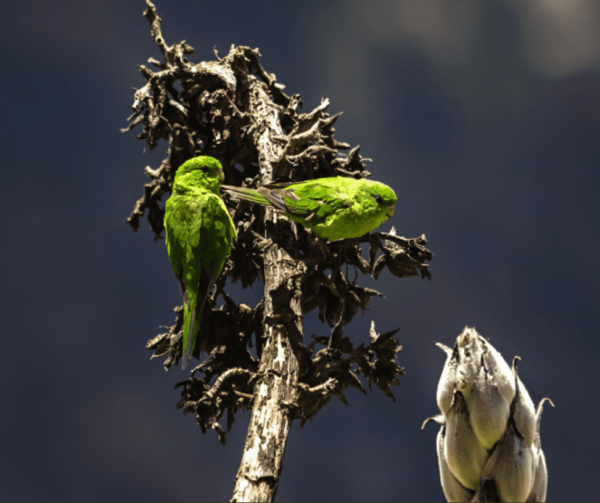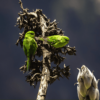Andean Parakeet
DID YOU KNOW?
The Andean Parakeet nests in burrows in steep banks.

Bolborhynchus

orbygnesius
Size:
17 cm (6.63 in)
Weight:
Not recorded.
Subspecies including nominate:
one
Colour Adult:
Both adults green in general; yellow tinge to forehead and lores, less evident in female; blue/green greater underwing coverts and undersides of flight feathers. Beak pale yellow/green with grey at base. Eye dark brown.
Colour Juvenile:
As in adults but with shorter tail.
Call:
Calls made in flight are chattering and rapid notes. Alarm calls are heard as rolling rrueet-ee, rrueet-ee.
More Information:
Content Sources:
CITES
BirdLife International
Cornell Lab of Ornithology/Birds of the World
A Guide to Parrots of the World, Juniper and Parr, 1998.
Parrots of the World, Forshaw, 2006.
Lexicon of Parrots, Thomas Arndt.
Captive Status:
Rare in captivity.
Longevity:
—
Housing:
Colony type housing in spacious indoor or outdoor (if in warm climate) aviary 5 x 3 x 2 m (16.4 x 9.84 x 6.56 ft).
Diet:
Seed mix such as: millet, canary, hemp, oats and niger; wild bird food; fruits such as: apple, pear, orange, banana, dried mountain ash berries, pomegranate, cactus fruits; vegetables such as: carrot, celery, green beans and peas in the pod; green leaves such as: Swiss chard, lettuce, dandelion, chickweed, sowthistle; vitamin C and other supplements; eggfood for rearing; complete kibble if taken.
Enrichment:
Provide fresh, unsprayed branches with buds for chewing, plenty of perches.
Nest Box Size:
Vertical box 8″ x 8″ x 12″ (20.3 cm x 20.3 cm x 30.5 cm)
Clutch Size:
4-6
Fledging Age:
6-7 weeks
Hatch Weight:
—
Peak Weight:
—
Weaning Weight:
—
World Population:
Unknown; described as fairly common but patchily distributed. Stable.
IUCN Red List Status:
Least Concern
CITES Listing:
Appendix II
Threat Summary:
No threats at present; population stable.
Range:
N Peru to CW Bolivia.
Habitat:
Found from 3000-4000 m (9840-13,120 ft) in semi-arid upland woods in subtropical and temperate zones including drier cloud forests, bushy habitats in ravines in open country, elfin woodland at edge of paramo and grassy slopes with bromeliads and scattered woodland patches. May also visit rural areas and farmland.
Wild Diet:
Diet consists of seeds, fruits and berries, taken in bushes, bamboo, leguminous trees and on the ground.
Ecology and Behaviour:
Gregarious; seen in pairs, small groups and occasionally large flocks of over 300 birds. Feeds in bamboo, brambles and leguminaceous trees. Forages in vegetation or on the ground.
Clutch and Egg Size:
4-6 eggs
Breeding Season:
Possibly a cliff bank nest; no other information.

